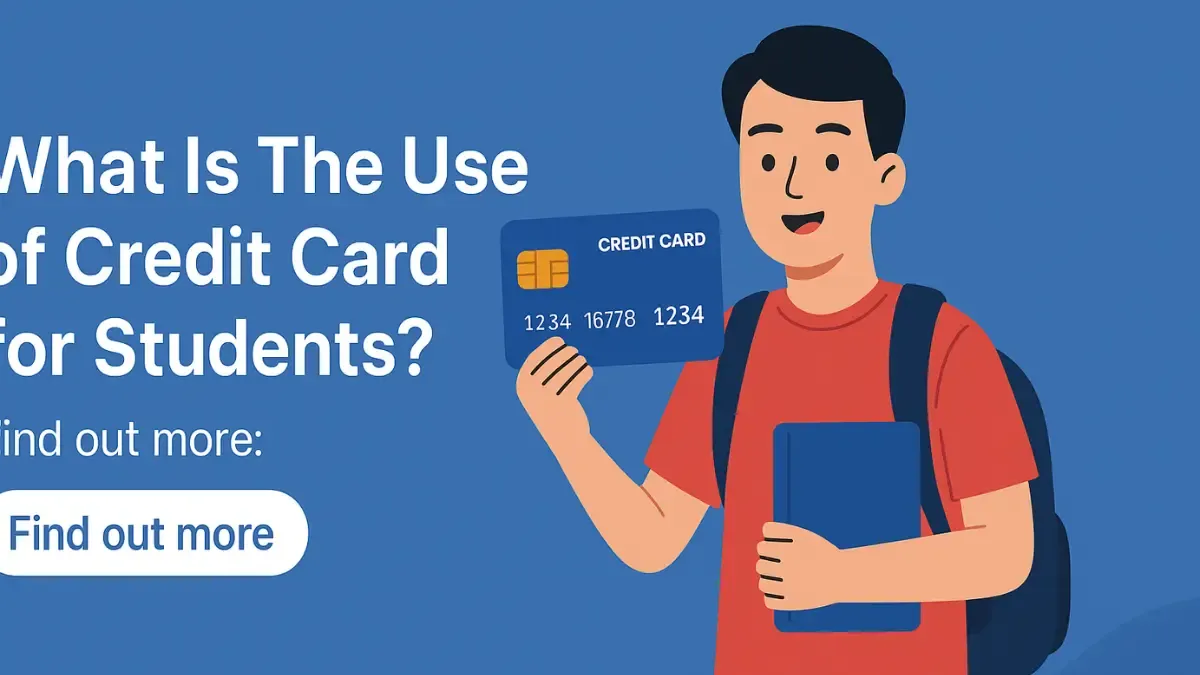Imagine buying books, booking tickets, or grabbing a coffee—all with one swipe, even before payday. All this can be done easily with a Credit Card.
For students, a credit card is not just a plastic card; for them, it is a smart financial tool that teaches them responsibility, builds credit history, and offers surprising perks. But is it worth it? To know it and where it can be used by students, let's dive into the article.
What is a Credit Card?
A credit card is a small plastic or metal card issued by a bank or financial institution that allows you to borrow money for purchases, services, or even cash withdrawals, up to a certain limit.
Essentially, it works like a short-term loan, and you’re expected to pay back the amount spent, either in full or through monthly installments, within a specified time frame.
How Does a Credit Card Work?
Every credit card comes with a pre-approved spending limit based on your income or financial history. Many credit cards provide perks like cashback, reward points, or discounts on travel, dining, and shopping. You can use them later within the specified time.
For example, if your credit limit is ₹50,000, you can spend up to this amount in a billing cycle. It’s important to stay within your budget and pay your bills on time to avoid debt or interest charges.
Where are credit cards used?
Credit cards are versatile and widely accepted for various purposes. They can be used for online shopping, in-store purchases, dining, entertainment, utility bills, education, healthcare, fuel payments, subscriptions, emergency expenses, etc.
Thus, we have learnt that credit cards can be used in a wide areas.
Now, let's have a breakdown of where students can make the most of their credit cards:
What is the Use of a Credit Card for Students?
Credit cards are incredibly versatile, and for students, they can be especially useful in specific scenarios. Such as:
1. Online Shopping
Use credit cards to buy books, gadgets, clothes, or groceries.
Example - Purchasing textbooks or a new phone on Amazon.
2. Paying Subscription Fees
Useful for paying for educational platforms like Udemy and Coursera, or entertainment services like Netflix and Spotify.
Example: Paying monthly for a Grammarly Premium subscription for essay editing.
3. Dining and Entertainment
Avail discounts on food delivery apps (like Zomato and Swiggy) or movie tickets.
Example: Watching a movie with friends while earning cashback.
4. Travel and Accommodation
You can book train, bus, or flight tickets and even pay for hotel stays.
Example: Using a credit card for a last-minute train booking to attend a seminar.
5. Emergency Expenses
Covers medical emergencies or urgent needs like car repairs.
Example: Paying hospital bills during a medical emergency.
6. Education-Related Expenses
Pay tuition fees, course registrations, or exam fees.
Example: Paying for an online certification course with a credit card.
7. Buying Electronics
Great for purchasing laptops, tablets, or other gadgets with installment options.
Example: Buying a laptop for studies and paying in monthly EMIs.
8. Study Abroad Expenses
Helps with international transactions for fee payments, travel, and living costs.
Example: Paying tuition fees in a foreign currency without extra hassle.
9. Building Credit History
Using a credit card responsibly helps students establish their credit score.
Example: Making monthly payments for groceries to build financial credibility.
10. Shopping Offers and Discounts
Enjoy exclusive student discounts and cashback on purchases.
Example: Get 10% off on a clothing sale at Myntra using your card.
Practical Examples of Credit Card Usage by Students
How can credit cards help Students in different situations?
| Scenario | How a Credit Card Helps |
|---|---|
| Online Course Subscription | Pay for Coursera or Udemy courses conveniently. |
| Buying Study Materials | Order books and supplies on Amazon with cashback. |
| Traveling Home During Holidays | Use credit cards for discounts on ticket bookings. |
| Dining with Friends | Avail discounts at partner restaurants. |
| Emergency Medical Bills | Pay instantly without waiting for funds. |
Risks of Credit Cards for Students
1) Overspending Temptation
Easy credit access may lead to spending more than they can afford.
Example: A student might buy a high-end smartphone on EMI, ignoring their repayment capacity.
2) High Interest Rates
Carrying an unpaid balance results in significant interest charges.
Example: A ₹5,000 balance left unpaid can quickly grow to ₹7,000 due to compounding interest.
3) Low Credit Limits
These may not cover large or unexpected expenses.
Example: A credit limit of ₹15,000 may not be sufficient for emergency travel expenses abroad.
4) Hidden Fees
Late payment charges, annual fees, or foreign transaction costs can add to the financial burden.
Example: Missing a ₹500 payment might result in a penalty of ₹200, increasing the debt.
Tips for Students to Use Credit Cards Wisely
1) Set a Spending Limit: Only spend what you can repay comfortably.
2) Pay in Full Each Month: Avoid interest charges by clearing the entire balance.
3) Track Expenses: Use mobile banking apps to monitor spending habits.
4) Choose the Right Card: Select cards with low fees and relevant rewards for your needs.
5) Avoid Cash Withdrawals: High fees apply for cash advances on credit cards.
Credit cards are excellent tools for students to develop financial independence and responsibility when used cautiously. From managing everyday expenses to building a credit history, they can significantly simplify life.
However, students must remain disciplined, avoid overspending, and understand the card’s terms and conditions to make the most out of it. Choosing a card tailored to their needs—like those with low fees and relevant rewards—ensures maximum benefits with minimal risks.
>Related Topics:





